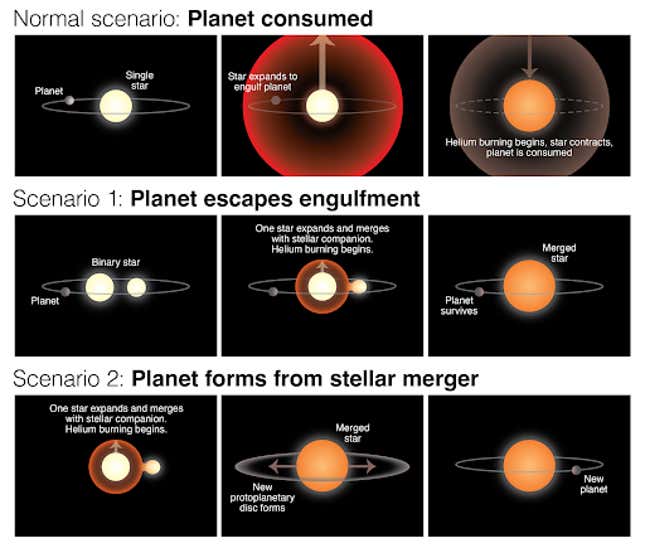The seek for planets outdoors our Photo voltaic System – exoplanets – is among the most quickly rising fields in astronomy. Over the previous few many years, greater than 5,000 exoplanets have been detected and astronomers now estimate that on common there’s a minimum of one planet per star in our galaxy.
Many present analysis efforts intention at detecting Earth-like planets appropriate for all times. These endeavours give attention to so-called “principal sequence” stars like our Solar – stars that are powered by fusing hydrogen atoms into helium of their cores, and stay steady for billions of years. Greater than 90% of all identified exoplanets up to now have been detected round main-sequence stars.
As a part of a world crew of astronomers, we studied a star that appears very like our Solar will in billions of years’ time, and located it has a planet which by all rights it ought to have devoured. In research printed at this time in Nature, we lay out the puzzle of this planet’s existence – and suggest some potential options.
A glimpse into our future: purple large stars
Identical to people, stars bear adjustments as they age. As soon as a star has used up all its hydrogen within the core, the core of the star shrinks and the outer envelope expands because the star cools.
On this “purple large” part of evolution, stars can develop to greater than 100 instances their authentic dimension. When this occurs to our Solar, in about 5 billion years, we anticipate it is going to develop so massive it is going to engulf Mercury, Venus, and probably Earth.
Finally, the core turns into sizzling sufficient for the star to start fusing helium. At this stage the star shrinks again to about 10 instances its authentic dimension, and continues steady burning for tens of thousands and thousands of years.
We all know of a whole bunch of planets orbiting purple large stars. One in every of these is known as 8 Ursae Minoris b, a planet with across the mass of Jupiter in an orbit that retains it solely about half as removed from its star as Earth is from the Solar.
The planet was found in 2015 by a crew of Korean astronomers utilizing the “Doppler wobble” method, which measures the gravitational pull of the planet on the star. In 2019, the Worldwide Astronomical Union dubbed the star Baekdu and the planet Halla, after the tallest mountains on the Korean peninsula.
A planet that shouldn’t be there
Evaluation of recent information about Baekdu collected by NASA’s Transiting Exoplanet Survey Satellite tv for pc (TESS) house telescope has yielded a shocking discovery. In contrast to different purple giants we have now discovered internet hosting exoplanets on close-in orbits, Baekdu has already began fusing helium in its core.
Utilizing the strategies of asteroseismology, which studies waves inside stars, we will decide what materials a star is burning. For Baekdu, the frequencies of the waves unambiguously confirmed it has commenced burning helium in its core.
The invention was puzzling: if Baekdu is burning helium, it ought to have been a lot larger up to now – so huge it ought to have engulfed the planet Halla. How is it potential Halla survived?
As is commonly the case in scientific analysis, the primary plan of action was to rule out essentially the most trivial clarification: that Halla by no means actually existed.
Certainly, some obvious discoveries of planets orbiting purple giants utilizing the Doppler wobble method have later been proven to be illusions created by long-term variations in the behaviour of the star itself.
Nevertheless, follow-up observations dominated out such a false-positive state of affairs for Halla. The Doppler sign from Baekdu has remained steady over the past 13 years, and shut research of different indicators confirmed no different potential clarification for the sign. Halla is actual – which returns us to the query of the way it survived engulfment.
Two stars turn into one: a potential survival state of affairs
Having confirmed the existence of the planet, we arrived at two eventualities which might clarify the state of affairs we see with Baekdu and Halla.
A minimum of half of all stars in our galaxy didn’t type in isolation like our Solar, however are a part of binary methods. If Baekdu as soon as was a binary star, Halla might have by no means confronted the hazard of engulfment.

A merger of those two stars might have prevented the enlargement of both star to a dimension massive sufficient to engulf planet Halla. If one star grew to become a purple large by itself, it will have engulfed Halla – nonetheless, if it merged with a companion star it will soar straight to the helium-burning part with out getting large enough to succeed in the planet.
Alternatively, Halla could also be a comparatively new child planet. The violent collision between the 2 stars might have produced a cloud of gasoline and mud from which the planet might have fashioned. In different phrases, the planet Halla could also be a lately born “second era” planet.
Whichever clarification is appropriate, the invention of a close-in planet orbiting a helium-burning purple large star demonstrates that nature finds methods for exoplanets to seem in locations the place we’d least anticipate them.
This text is republished from The Conversation beneath a Artistic Commons license. Learn the original article.
Trending Merchandise

Cooler Master MasterBox Q300L Micro-ATX Tower with Magnetic Design Dust Filter, Transparent Acrylic Side Panel…

ASUS TUF Gaming GT301 ZAKU II Edition ATX mid-Tower Compact case with Tempered Glass Side Panel, Honeycomb Front Panel…

ASUS TUF Gaming GT501 Mid-Tower Computer Case for up to EATX Motherboards with USB 3.0 Front Panel Cases GT501/GRY/WITH…

be quiet! Pure Base 500DX Black, Mid Tower ATX case, ARGB, 3 pre-installed Pure Wings 2, BGW37, tempered glass window

ASUS ROG Strix Helios GX601 White Edition RGB Mid-Tower Computer Case for ATX/EATX Motherboards with tempered glass…










